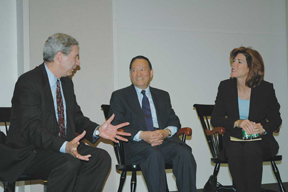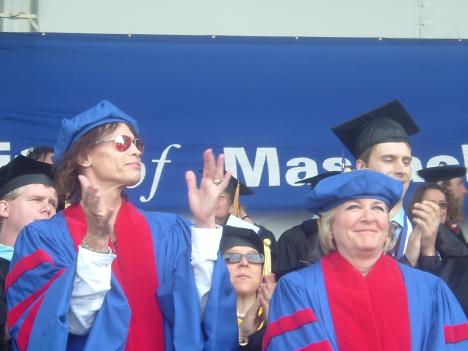Social Security: A Concern For the Young and Old

Margaret Brett
Yung-Ping Chen (center), holder of the Frank J. Manning Eminent Scholar´s Chair in Gerontology at UMB, organized a Social Security forum last Monday at UMB
April 21, 2005
By DENA CAPANOContributing Writer
Social security is a rising concern among the baby-boomer population (those born in 1946-1964, eligible to retire as early as age 62 in 2008, only 3 years from now.) Yung-Ping Chen, holder of the Frank J. Manning Eminent Scholar’s Chair in Gerontology at UMB, pointed out, “Social Security is not just for old folks. Many young people receive benefits as dependents and survivors of retired and disabled workers.” To assist the national debate on how to reform the Social Security program, Chen organized a Social Security forum last Monday at UMass Boston.
People from all walks of life gathered in the Campus Center Ballroom to hear from one of the nation’s leading experts on Social Security, Stephen C. Goss, the Chief Actuary of the Social Security Administration. Goss, according to Chen, was invited to UMB to present the facts, but not pass judgment on any specific reform plans. Chen explained, “People of all ages need unbiased information to distinguish among different ideas for reform.”
During Chen’s introduction, he put forward examples of biased and inaccurate information in the mainstream media, “A couple of months ago, an award-winning television host stated that President Roosevelt was smart to have the retirement age for Social Security benefits set at 65 because the average life expectancy in those days was about 62 or 63 years of age…He failed to distinguish between ‘life expectancy at birth’ and ‘life expectancy at age 65.'”
But what did Roosevelt envision for workers in America when in 1934, he asked his Labor Secretary, Francis Perkins, to look into a program that would help people protect themselves against being impoverished by unemployment or old age? According to an article in The American Scholar, Robert M. Ball writes, “He wanted it to be a system into which people contributed while they were working, so that when the time came to call upon the program for help they could hold their heads high and claim benefits as an earned right.”
Seventy years later, the program signed into law in 1935 by Roosevelt is in need of reform, partly due to the rise and fall of birth rates after WWII. “Society as a whole made a choice to have fewer kids,” Goss stated. Consequently, workers per beneficiary will shift to a new lower level. Goss projected slides displaying a brief history of Social Security. “Without change, trust funds will run out and benefits will be reduced,” Goss told the audience.
The estimated year that trust funds are expected to run out is 2041, which is why Social Security is a concern for young people as well as old. Goss deemed this as an “urgent problem” and pointed out several options on how social security’s income and outgo could be brought into balance.
Three major choices Goss presented were “raising scheduled revenue, lowering scheduled benefits, and to increase retirement age.” He told the audience, “People are more fit and active at 65,” justifying the last option as a feasible one.
By implementing these reforms, one may ask, is raising retirement age and lowering benefits the bleak future American workers have to look forward to? Chen says, “I think the best way is to consider those ideas in the context of restoring solvency of the program. In other words, to make sure Social Security will have enough money to pay benefits.”
The revenue raising measure would increase the amount of money workers contribute to Social Security. In turn, more money would be planted into the program without raising retirement age or lowering benefits. By 1990, worker contribution rates rose to 6.2%, for both the employer and employee on earnings up to $51,300, and they are continuing to rise.
Additionally, Chen emphasized that more than one in three beneficiaries are not retired workers, “Of the 47 million Social Security recipients now, 5.9million are disabled workers, 6.8 million are survivors of deceased workers, and 4.8 million are spouses and children of retired and disabled workers.” As for the workers who are taxed, Chen stated, “Nearly 160 million workers of all ages now pay taxes into it.”
Approximately 200 people attended the forum, which was sponsored by the Gerontology Department and Gerontology Institute of the newly established McCormack Graduate School of Policy Studies. Several constructive comments on Goss’ presentation were heard. Upon departure from the forum, one anonymous Dorchester resident commented, “the problem is clear, but Goss’s presentation was hard to follow. I guess it’s hard to be summed up for the average person to understand.” She continued thoughtfully, “One thousand dollars a month isn’t very much to live on.”



















































